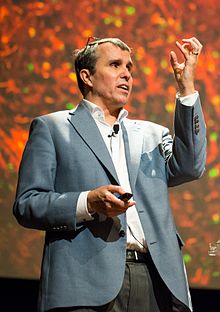Eric Betzig
| Eric Betzig | |
|---|---|
 |
|
| Born | Robert Eric Betzig January 13, 1960 Ann Arbor, Michigan, U.S. |
| Fields | Applied physics |
| Institutions | Howard Hughes Medical Institute |
| Alma mater |
California Institute of Technology Cornell University |
| Thesis | Near-field Scanning Optical Microscopy (1988) |
| Known for | Nanoscopy, fluorescence microscopy |
| Influences | William E. Moerner |
| Notable awards | Nobel Prize in Chemistry (2014) |
|
Website Eric Betzig, PhD |
|
Robert Eric Betzig (born January 13, 1960) is an American physicist based at the Janelia Farm Research Campus in Ashburn, Virginia. He has worked to develop the field of fluorescence microscopy and photoactivated localization microscopy. He was awarded the 2014 Nobel Prize in Chemistry for "the development of super-resolved fluorescence microscopy" along with Stefan Hell and fellow Cornell alumnus William E. Moerner.
Betzig was born in Ann Arbor, Michigan in 1960, the son of Robert Betzig, an engineer, and Helen Betzig. Aspiring to work in the aerospace industry, Betzig studied Physics at the California Institute of Technology and graduated with a BS degree in 1983. He then went on to study at Cornell University where he was advised by Aaron Lewis and Michael Isaacson. There he obtained an MS degree and a PhD degree in Applied and Engineering physics in 1985 and 1988, respectively. For his PhD he focused on developing high resolution optical microscopes that could see past the theoretical limit of .2 micrometers.
After receiving his doctorate, Betzig was hired by AT&T Bell Laboratories in the Semiconductor Physics Research Department in 1989. That year Betzig's colleague, William E. Moerner, developed the first optical microscope that could see past the .2 micrometer limit, known as the Abbe limit, but it could only function at temperatures near absolute zero. Betzig was awarded the William L. McMillan Award in 1992. Inspired by Moerner's research, he became the first person to image individual fluorescent molecules at room temperature while determining their positions to more than .2 micrometers in 1993. For this he received the William O. Baker Award for Initiatives in Research which was at the time, the National Academy of Sciences Award for Initiatives in Research.
...
Wikipedia
